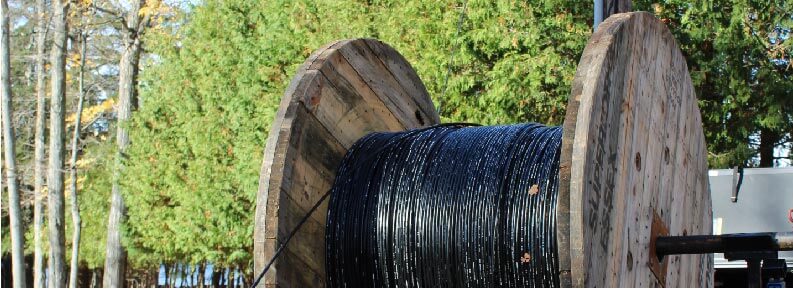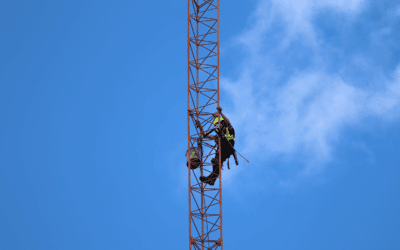Storm Internet’s Fibre to the Home Rollout is Underway in Clayton
CLAYTON — A little more than a year after breaking ground, Storm Internet Services (Storm) has begun connecting fibre-to-the-home (FTTH) customers in this Eastern Ontario village, after completing the main subterranean lines of a new fibre broadband network.
Headquartered in Ottawa, the firm recently marked the milestone achievement of being able to offer Clayton residents fibre-line Internet featuring speeds exceeding those found in Canada’s biggest urban environments.
The Storm team is now busily hooking up homes to upload/download speeds of 500 Mbps/500 Mbps at the top level, ranging down to a 50 Mbps/50 Mbps package whose performance still far exceeds old copper DSL technology that never even existed in Clayton to begin with.
Undertaken entirely without government funds, the FTTH project grew out of the concerns of a local citizen’s group over lack of broadband in the Municipality of Mississippi Mills, especially Clayton. Armed with a survey showing strong local demand, the ‘MM2020’ committee approached Storm about creating the company’s first-ever residential fibre network from scratch, to bring about the goal of making such service available to every home by the end of this year.
About 120 individual households signed up in advance, and it was a ‘go.’
A worker on a tracked drill creates a hole for pipe beneath a road or laneway, through which fibre-optic cable was pulled as part of Storm’s FTTH project, earlier this year.
While the Canadian shield proved a greater than expected challenge in trenching the 15 kilometres of fibre-optic cable comprising the backbone of the Clayton network — adding time to the build— the Storm team prevailed on the “proof of concept” project.
“We now consider ourselves ‘fibre experts,’ having overcome so many obstacles,” observes Gayle Moore, Storm VP Human Resources & Administration/Corporate Secretary. “Our team members are too many to mention … it was a small village that helped Storm’s Clayton project become a reality and our first successful residential fibre-to-the-home rollout.”
MM2020 member and former Mississippi Mills councillor Paul Watters says he’s been hearing “very good things” from those already connected as well as others in the process. “We couldn’t get a better group of people than the Storm people,” says Watters, also lauding the firm’s employees for setting up individual modems to ensure working service, rather than just handing equipment over to the newly connected.
The Storm crew prepares a “drop install” — laying a section of fibre-optic cable into a home being connected to the company’s new FTTH network in Clayton.
Beyond fast download speeds, Clayton households now enjoy access to equally quick upload performance, which is critical for video-conferencing (such as Zoom) as well as stable VPN connections for communicating back to a corporate office. And that, he points out, is crucial for the 38 percent of residents who have indicated they are telecommuters.
“Man, they’ve got good people working there,” he adds of Storm. “My hat goes off to them.”
Despite its close proximity to the Nation’s Capital, the village lacked any kind of wired broadband service, until now. While Storm already offers its well-known fixed wireless broadband service in the area, the hilly and treed geography of Mississippi Mills sometimes requires the customer to purchase a tower — a cost avoided for those in reach of the new FTTH project. Unfortunately, not quite as many households are located along Storm’s new fibre routes as originally envisioned: Those earlier technical challenges with the hard Lanark County ground and related extra costs have forced the company to shorten the runs somewhat, curtailing availability of FTTH to about 90 Clayton addresses at this time.
“We would very much like to continue to provide FTTH to more residents in the Clayton area and beyond, but without financial support from communities, municipalities and government, expansion will only be possible as our cash flow permits,” observes Michel Lalonde, VP Operations and Sales. “Maintaining and expanding our wireless network will continue to be Storm’s number one priority especially during this global pandemic as we have so many clients depending on us during this very difficult time.”
Storm technicians trench a cable through a yard to connect a home to the main fibre-optic line along the road.
“They’re not getting any municipal funding … they’re not getting anything from the government, so to speak,” observes local resident Katie Peter. “So this is coming out of Storm’s pocket,” adds Peter, also expressing regret that permission to use existing utility poles in Clayton was not forthcoming, compelling the installers to go underground with the fibre. “That’s something I feel should change,” offers the former member of the MM2020 group. “I feel the poles have been paid for.”
Peter says she understands the constraints that have placed FTTH out of reach to about 30 Clayton homes, including her own, though she admits “feeling quite envious” of those folks in the village who have managed to tap in.
“This is just the beginning, this is just the tip of the iceberg of the potential,” she enthuses, adding of Storm: “I’m for any small business that’s willing to put some backbone behind what they’re saying to move things forward for the better of a community.”
Peter currently relies on a satellite Internet connection — at a whopping $230 per month — with an anemic upload of just over 1.5 Mbps and highly susceptible to weather variation. While “better than nothing,” she says it’s far short of the value and performance of FTTH.
“This isn’t just about Netflix and streaming,” adds Peter of the need for robust connectivity — upload included — to keep people in a rural community like Clayton. She notes the example of her senior neighbours for whom video conferencing would be a vast improvement to communicate with family, especially if they are hearing impaired — or with virtual doctors’ visits. Other neighbours have children attending not only elementary and secondary level classes from home — during these COVID-19 times — but college and university as well. Still others have home-based businesses or are trying to work from home.
Splicing fibre-optic cable is a necessary part of creating a fibre network. This is Storm’s splicing unit.
Storm’s FTTH rollout to eligible Clayton residents comes as Mayor Christa Lowry describes Mississippi Mills as still “a world behind in connectivity” and acknowledges her township’s continued “frustration” over that reality.
“Current investments across Ontario will still leave many residents unserved and the current COVID-19 pandemic has further underscored this digital divide,” notes Lowry, whose council voted unanimously June 16 to decry the “limited to non-existent” Internet access in many rural communities. The circulated resolution urges the provincial and federal governments to ensure rural broadband projects qualify for shovel-ready infrastructure spending as part of future economic recovery plans.
“I can think of no more impactful an investment to our economic recovery than investing in rural broadband so that all Ontarians can access this essential service,” adds Lowry, who intends to press this case with members of the Ford cabinet at the Association of Municipalities of Ontario conference in August.
The delegation from Mississippi Mills will also highlight how lack of access to utility poles impedes smaller Internet service providers (like Storm) from filling the gaps in rural Ontario, says the mayor, who asserts that it’s time to “even the playing field.”
While Clayton represents Storm’s first foray into FTTH, the private company does have previous fibre experience on the business side, operating a fibre-optic network it installed at the 417 Business Park in Vars six years ago. And Storm CEO Birket Foster says the latest project means Storm could be on the lookout for more underserved villages interested in deploying FTTH in the future.
Among Eastern Ontario’s first Internet Service Providers when established in 1996, Storm has focused on continuous innovation and client-driven service and support that consistently exceed expectations. Serving both residential and small-to-medium sized business clients in Eastern Ontario, the firm provides high-speed access across 8,000 square kilometres of the Ottawa Valley and beyond — with a particular focus on wireless delivery. Storm also operates as a third-party DSL and cable internet reseller in more urban markets.

MORE POSTS
Coyotes Soccer Team
The Coyotes are Back in Action!Tournaments finally return. Storm Internet is a proud sponsor of...
Angella Goran: One Hour to Make History?
One Hour to Make History?Angella Goran’s journey to the UCI World Record attempt. Storm Internet...
Climbing to New Altitudes to Bring you the Highest Quality Internet
Climbing to New Altitudes to Bring you the Highest Quality InternetThe team is hard at work to...
CONTACT US
Head Office
1760 Courtwood Crescent
Ottawa, ON K2C 2B5
TOLL-FREE: 1-866-257-8676
Rediscover Customer Service.
HOURS OF OPERATIONS
Support Hours:
Monday-Friday 8am-9pm
Saturday-Sunday 9am-5pm
Sales Hours:
Monday-Friday 8am-4pm
Billing Hours:
Monday-Friday 9am-5pm
BUSINESS SERVICES
RESIDENTIAL SERVICES
TERMS OF SERVICE | PRIVACY POLICY | CORPORATE RESPONSIBILITY POLICY | ACCESSIBILITY | VOIP 911 TERMS
© Copyright 1996-2022 Storm Internet Services | All Rights Reserved.



